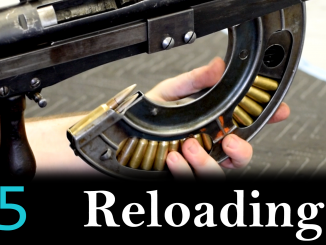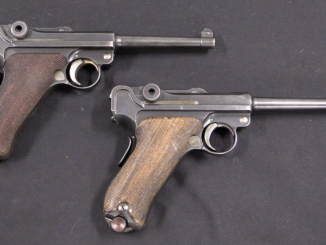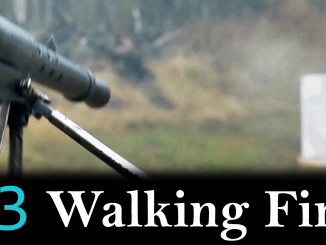The Madsen LMG is of particular interest to me because it is both a very mechanically unusual design and also a very early successful design. Madsen light machine guns were first used in combat in the Russo-Japanese War, saw use in both World Wars, and continued to be used by various forces (the Brazilian police being a notable example) until quite recently. Mechanically, the Madsen is a falling block type of action, which allows it to use a very short receiver (since there is no need for space for a bolt to travel forward and backward). Today I figured we would spend time pulling apart a live registered Madsen (a dealer sample, unfortunately) to examine its working parts.
Related Articles

Light MGs
Project Lightening Episode 05: Reload
Project Lightening is a collaborative series with Othais and Mae of C&Rsenal in which we test all seven light machine guns and automatic rifles of World War One and put them through a series of […]

Semiauto pistol
Portuguese Army Lugers: From Manuel II to World War Two
Portugal first tested the Luger pistol in 1901, and its commission on self-loading pistols recommended the design for adoption in 1904. No money was available at the time, but a second commission again recommended the […]

Light MGs
Project Lightening Episode 03: Walking Fire
Project Lightening is a collaborative series with Othais and Mae of C&Rsenal in which we test all seven light machine guns and automatic rifles of World War One and put them through a series of […]

In Portugal these would probably be in 8 mm IS, they were used in the colonial wars to arm light armoured vehicles like the Daimler Dingo, often with a box-like extension on top allowing it to be driven open without asphyxiating the occupants in the African heat. I find it strange that it has a 30-06 magazine (presumably the barrel is also 30-06), perhaps the swap was done in the US as 30-06 is not at all a common caliber in Portugal. At this time the G3 automatic rifle was in use in 7.62 NATO, replacing the Mauser 98K and some Ar-10’s. There were some aircraft gun pods in 7.7 mm purchased from France (which I presume are ex-RAF Brownings in .303). There were also Bren guns in .303 but uncommon and probably only in barracks in Portugal. The standard medium machine gun up into WW2 and beyond was the Vickers, locally modified to 8 mm IS, and the light MG was the unimpressive Dreyse. Both replaced by the MG42 (MG3) and the HK21 in 7.62 mm Nato. At this time, with embargoes all over the place Portugal had to make do with whatever it could find. The Alouette III helicopter for example had a German autocannon in 20 mm.
Richard,
I agree that the gun in the video must have been subjected to conversion to 30.06 by some US user.
The first Madsens purchased by the Portuguese were in .303 (the model m/930, or Metralhadora Madsen 7,7mm Madsen m/930, to use the full official designation). Then you have the m/940 in 7.92 Mauser, actually the first model to be purchased in that calibre, after the Portuguese military changed the rifle and mg calibre from 6.5 Vergueiro and .303 to 7.92 Mauser in 1937.
Then there’s the Madsen m/940-41, i.e. Madsens originally bought from Dansk Rekylriffel Syndikat in .303 and converted at the FBP arsenal to 7.92 Mauser. The Portuguese were so enamoured with the Madsen they even negotiated a licence with the Danes to manufacture the gun locally. Also please note that there were Vickers in .303 actually made by FBP, not just modified: these were the Vickers 7,7mm m/930. Later on, FBP converted both original British and locally made Vickers to 7,92 Mauser, but many of the Vickers extant in the African colonies (as the Madsens too) remained in .303 till the early 1960s (I suppose those guns were never converted to the Mauser round), as most of the ammunition stocks held there were of .303.
The magazine is labeled 30.06 but at no time is the gun said to be chambered for 30.06.
The narrator clearly states that the magazine is also compatible to 8mm Mauser ammunition. So it is possible that this particular gun is chambered for 8mm. I do not know if the Portuguese used this round or not and will have to look into that.
I just read the 2nd comment again and apparently the Portuguese Madsens were chambered for 8mm Mauser .
I have Melvin Johnson’s book describing this, but you can’t understand it without seeing it. Thank you.
A very interesting firearm. Thank you for the very clear explanation.
I have one question however. Since the rammer is beside the breech block and pushes on the cartridge, does this mean that the breech block does not cover the entire base of the cartridge? If not, then how much of the cartridge base is exposed? Does the rammer act to support the cartridge base in any way when fired?
I think it covers it more or less entirely, the breech block feed tray thing that the cartridge sits in from the magazine appears angled slightly towards the breech, so there’s enough of the cartridges rear for the rammer to engage to push the cartridge into the breech but when it’s in the breech there’s probably less of the rear of the cartridge in contact with the rammer, some but not much.
I’ve seen this described in WHB Smith’s _Small Arms of the World_ as a “long recoil” system. I presume this is because the barrel never comes to a halt while other pieces, like a breech block, continue moving.
This gun is ingenious for trading vertical movement of the breech block and that long cartridge feed-arm lever for the more common movement of a breech block along the barrel axis.
I swear I just saw a transferable Madsen LMG in gorgeous condition in the catalog for the upcoming RIAC auction on the 4/5/6th of December. Excellent video, one of my favorite firearms these days.
Talking about WW1 and Madsen – Germans were just one user (Madsen-Muskete were used in cavalry) but I’d like to stress that was used in even larger extent by the Russians, who even built a factory to manufacture them under license at Kovrov. The Madsens in Russia were used not only as land guns, but as aerial MGs as well, on defensive positions in the world’s first 4-motor heavy ‘strategic’ long range bomber, the RBVZ Ilya Muromyets. As the war started, the Danish withdrew from Russia (just as they did with Germany) to protect their neutrality, and the factory was never completed. Later, after the Bolshevik Revolution, it was given over to Fedorov, who started to manufacture his Avtomat in 6.5 mm Japanese there – with his proletarian protege, Vasily Degtyarov (aka Degtarev) who later helmed the factory and KB-2 design bureau there until after WW2. Now the former Madsen factory is known as the Zavod im. Dyegtyarova, famous for the AEK-971 / A-545 – current contender for the new Russian assault rifle.
Anyone who would like to see Madsen in transport, setting up on tripod and bipod, as well as handling, reloading and action shooting, is recommended to find on the internet the 2015 Danish movie ‘9 April’ depicting the German invasion of Denmark in 1940. Also in that movie there are scenes with the motocycle sidecar mounted 20 mm variation of the Madsen.
See REPTILICUS, the 1961 Danish creature feature (Gott-Zilla?). Lots of Madsens 7 other interesting goodies- Forgotten Weapons post Oct. 19 2014
My Grandfather, Karl Blomqvist was hired by the Dansk Riffel Syndikat and was in place in Kovrov, Russia one week prior to the Spring Revolution. He was set to wire the factory for AC/DC but as you said, Denmark pulled out, which left my Grandfather as an enemy of the state. Leszek, if you have any source material about the Dansk Riffle Syndikate license history in Russia, I’d be grateful if you could share that with me.
An important item you did not show is the guide plate on the right side of the gun which controls the movement of the ‘main’ pin on the breech assembly and if removed deactivates the gun completely.
At a recent reenactment show in the courtyard of the Tøjhus-museum in Copenhagen, one ‘live’ Madsen (probably also a Portugese contract) was provided by a local SFX company and one of the reenactors, a member of my rifle club got to fire it. Big grin on his face…
-S
cool gun. never understood why germany (or other countries) just didn’t simpy steal the design. the 08/15 is a so much inferior compared to this mg.
I think the issue has to do with the usual gun culture of the day. Remember that most colonial powers were buying up machine guns that were heavy tripod-mounted defensive pieces. The Madsen is intended for squad automatic support. Germans were into the Maxim and the Bergmann, and did not anticipate that the army required squad automatic weapons, not just artillery and company-defense HMGs.
Also, the MG08/15 was an expedient weapon rushed to fill several roles because weapons for those roles were not yet in production. It was not a dedicated redesign.
I suspect that reason might be that Madsen design is labour-expensive, however i don’t know which will require more time to produce 1 example: MG08/15 or Madsen?
ps: “dealer sample” means it can only be bought by other dealers? If so, what’s preventing you from becoming one?
The Soviet 1960s-era 2A14 23mm cannon (frequently seen on “technicals” in the Middle East) appears to be heavily influenced by the Madsen. It has a similar-looking yoke-like “accelerator” for ramming cartridges and also serves as the ejector. It has a vertically-sliding breach block and is gas-operated. It’s receiver is much shorter than its caliber would suggest.
Clever design.
Ian
Outstanding presentation !
The Madsen is an outstanding weapon . It’s complex but reliable,the ones I have fired are accurate.
What a marvelous mechanism. A full automatic Martini action. A combination of levers with genius. Seems dropped from another planet. Thanks Ian.
“A full automatic Martini action.”
The M-219 and M-85 are as well, just done far less successfully than the Madsen. I’ve NEVER seen or heard a complimentary comment about either of the former two.
Excellent design, automatic Martini. I wouldn’t say it was particularly the best design for changing barrels with having the mechanism attached. You could say well, your using a new cool mechanism each time but… The old one would be hot, you’d have to not drop it- So the mechanism in mud for reuse, it doesn’t look that easy to remove in battle. You could, but I wouldn’t be surprised if folk didn’t actually carry spare barrels/mechanisms that much with it being a light machine gun and the mechanism isn’t as cheap to make as a barrel alone. It’s alright, as a calibre swap idea on a range.
Splendid presentation, as usual, Ian. Thanks.
Andrzej.
Speaking of German appreciation of Madsen(or lack thereof) i read in Hogg’s “Infantry Weapons of the Second World War” (I think) that the Germans during the War developed the mechanism to convert Madsen to belt-feeding. The author calls its complexity “equal to operating two lifts in one shaft”.
Is there anything to it, or was it just a rumor?
Regards, Andrzej
R. Aballe, thank you for your comments.
I was aware that the Vickers MMG was also produced by FBP under licence, I do not however have any information regarding numbers.
I once had a look at a Portuguese manual for the Vickers, and it was by far the most detailed and thorough work I have ever seen, probably aimed at officers and NCO’s rather than the common soldier.
There is a Maxim in 6.5 mm Vergueiro with an enormous brass muzzle booster in the Museu Militar in Lisbon, I have a couple of pictures of it but missed the all important left hand side of the receiver, where the details would be, I think there was some other exhibit cluttering up the space. Remarkable that they got it to work on the 6.5 mm as it was not a powerful cartridge, and only with round-nosed bullets.
You are welcome, Richard. I don’t have any information regarding the totals of Vickers m/930 produced by FBP either, but my educated guess would be several hundreds and perhaps lots of spare parts for the British-made ones. Incidentally, it seems the guns were produced through reverse engineering, without access to original drawings. This seems to imply that no production licence was obtained.
Thanks for the interesting story on the manual. Did you manage to get it? I once lost (at a Spanish online auction site) a bid for a pair of incredibly detailed manuals for the Spanish Hotchkiss MMG and FA OC LMG (Fusil Ametrallador Oviedo-Coruña, sometimes also designated as FA Oviedo-Coruña M 1925/1938) and regret it till this day…
I remember the very same Portuguese Maxim you mention, in 6.5 Vergueiro, complete with its full gun carriage and armoured shield. I would like to compare the ballistics of the 6.5×58 Vergueiro with other 6.5 rounds from about the same era (esp. the 6.5 Arisaka and 6.5 Carcano); munición.org claims the original Portuguese military loading reached a speed of 2400fps with 155gr round-nosed bullets. Still referring to the Portuguese Maxims in 6.5 Vergueiro, maybe they used hoter 6.5 loadings.
There are about thirty pre-85 dealer sample Chilean M1946 guns in the United States in .30-06. They always work –though with that tall bipod, shooting them is like standing up in a canoe.
M
R. Aballe,
Alas I do not have the manual, there were several of them belonging to the father of a friend of mine who is (was?) an army officer (artillery). I once asked him to scan the manuals for me, I got a polite yes but that’s about all.
I also saw, from another source, manuals for assorted small-arms, including the FBP SMG which was prone to firing of its own accord. Again tons of detail on the bazooka, Instalaza, 60 mm mortar, demolition devices, etc. Again they were borrowed and returned to owner years ago.
Perhaps if one hunts about the internet in Portuguese something might crop up, I’ll see.
Regards
R. Aballe,
Hogg & Weeks, “Military small-arms of the twentieth century” 6th edition, quotes the following data:
6.5 x 54 Greek 10.32 grams 680 m/s Mannlicher
6.5 x 54R Dutch 10.3 g 740 m/s ”
6.5 x 50SR Arisaka 9.0 g 762 m/s
6.5 x 52 Italian 10.5 g 700 m/s Mannlicher-Carcano
6.5 x 55 Swedish 10.1 g 793 m/s
6.5 x 58 Portuguese 10.04 g 610 m/s Mauser-Vergueiro
The Mauser-Vergueiro was very popular with the German East Africa corps, when they captured some (which was often, read Paul Emil von Lettow-Vorbeck’s account, it is a primary reference text book on guerilla warfare), it allowed them to replace the smoky 11mm Mausers issued to the natives, and to replace the 8 mm Mausers when their ammo supply ran out. Very sweet to fire, reliable and generally handier than what the Germans had. The bolt was a pain in the xxxx to have to strip down and clean, as it was a Mannlicher-derived system designed by Capt. Vergueiro and not a Mauser.
Anyway if the above data can be taken as accurate, then the 6.5 x 58 was one of the lowest powered of the set.
Richard,
Hogg & Weeks’ figures, at least regarding the 6.5×58 Vergueiro, sound suspect to say the least.
This Russian website – http://shooting-iron.ru/board/10-1-0-132 – gives the following data:
6.5×58 Vergueiro, 10.17 g 783 m/s, which is fairly high (only surpassed by the 6.5 Swede)
R. Aballe,
Thanks for the reference, excellent data. Considering that the cartridge volume is not very different from 6.5 mm Swedish and similar ammunition, a higher velocity is more reasonable. Also it would work a lot better in a machine gun.
You are welcome. Yes, I think so. I also heard comments on the excellent inherent accuracy of the combo m/904 Vergueiro and 6.5×58 cartridge. The rifle was used for competition purposes in Portugal well until the 30s (presumably after the adoption of the 7.9 Mauser).
I’ve just revisited the pictures my son took of the 6.5 mm Maxim with the enormous muzzle booster. The close-up is a bit out of focus but it is probably not brass as I thought, but non-blackened steel with a fine patina of oxidation. It makes more sense, although the colour is easily mistaken for brass in artificial light. There’s an awful lot of brass on that gun.
My Madsen has a barrel/bolt unit in 7×57 Mauser, 7.92×57 Mauser and 30-06. They all use the same magazines and I can switch out the barrel/bolt unit in a couple of minutes. I shoot the gun off of its trial-pod which I am told inspired the German Lafette 34 as it has a spring absorber for the recoil. I really like shooting it almost more than the MG34 as it never jams. Harry